
The Pyralidae, commonly called pyralid moths, snout moths or grass moths, are a family of Lepidoptera in the ditrysian superfamily Pyraloidea. In many classifications, the grass moths (Crambidae) are included in the Pyralidae as a subfamily, making the combined group one of the largest families in the Lepidoptera. The latest review by Eugene G. Munroe and Maria Alma Solis retain the Crambidae as a full family of Pyraloidea.

Pterophorus pentadactyla, commonly known as the white plume moth, is a moth in the family Pterophoridae. It is found in the West Palearctic including North Africa and Europe. The wingspan is 26–34 mm (1.0–1.3 in). It is uniformly white, with the hind wing pair divided in three feathery plumes and the front pair in another two. The moths fly from June to August. The larvae feed on bindweed.

Daphnis nerii, the oleander hawk-moth or army green moth, is a moth of the family Sphingidae. It was described by Carl Linnaeus in his 1758 10th edition of Systema Naturae.
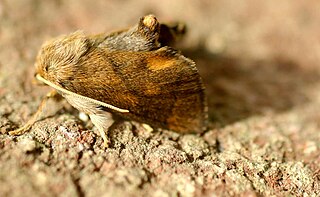
The Limacodidae or Eucleidae are a family of moths in the superfamily Zygaenoidea or the Cossoidea; the placement is in dispute. They are often called slug moths because their caterpillars bear a distinct resemblance to slugs. They are also called cup moths because of the shape of their cocoons.

Theretra silhetensis, the brown-banded hunter hawkmoth, is a moth of the family Sphingidae described by Francis Walker in 1856. It lives in Indo-Australia, India, Sri Lanka, Papua New Guinea, East Australia, Solomon Islands, Fiji Islands, Vanuatu Islands.
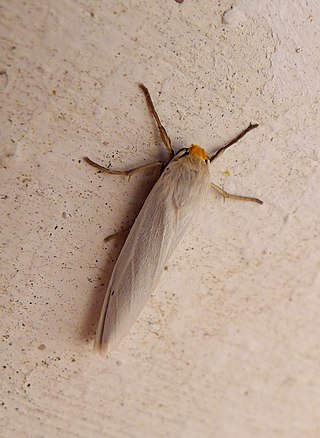
Manulea palliatella is a moth of the family Erebidae. It is found in southern, central and eastern Europe, Asia Minor, Iran, Afghanistan, Central Asia, Kazakhstan.
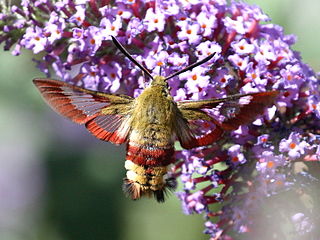
Hemaris fuciformis, known as the broad-bordered bee hawk-moth, is a moth of the family Sphingidae.

Hippotion velox, the dark striated hawkmoth, is a species of sphingid moth or the family Sphingidae. The species was described by Johan Christian Fabricius in 1793.
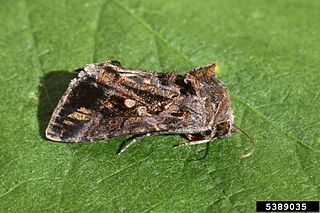
Chrysodeixis includens, the soybean looper, is a moth of the family Noctuidae. It is known as falso medidor in north-eastern Mexico. It is found from southern Quebec and southern Ontario through the eastern and southern part of the United States to Central America and South America, the Antilles and the Galápagos Islands. It is known to be migratory. The species was first described by Francis Walker in 1858.

Eusphecia melanocephala is a moth of the family Sesiidae. It is found in central, eastern and northern Europe and parts of western Europe as well as Asia. The range extends from the Pyrenees, through southern France and central Europe into Asia. In the north, it can be found up to Fennoscandia and in the south down to the southern edge of the Alps and the northern Balkans.

Acleris semipurpurana is a species in the moth family Tortricidae, and one of several species of moth commonly known as oak leaftier or oak leaf tier. The larvae feed on the leaves of oak trees in the Eastern United States and southeastern Canada which can be a major cause of defoliation. The loss of leaves can kill or damage the affected trees, which are chiefly in the Lobatae or red oak section of Quercus, or oaks.
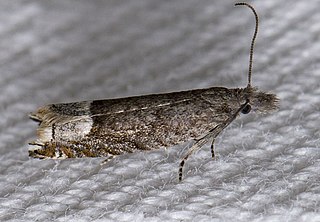
Ancylis tineana is a moth of the family Tortricidae. It is found from southern Sweden to Asia Minor and from the Trans-Caucasus to Siberia and the southern part of eastern Russia. It is also present in North America.
Ypsolopha instabilella is a moth of the family Ypsolophidae. It is found in Uzbekistan, Tajikistan, Kyrghyzstan, Asia Minor and in the southern part of eastern Europe.

Scopula incanata is a species of moth in the family Geometridae. It is found from north-eastern Europe and the Caucasus to southern Siberia and northern Mongolia.

Scopula virgulata, the streaked wave, is a moth of the family Geometridae. The species was first described by Denis & Ignaz Schiffermüller in 1775. It is found from most of Europe to central Asia and northern Mongolia.

Jordanita chloros is a moth of the family Zygaenidae.
Jordanita subsolana is a moth of the family Zygaenidae. It is found from southern Spain though the southern part of central Europe, Italy, the Balkan Peninsula and Greece to southern Russia and Ukraine, Turkey and Transcaucasia up to the Altai.
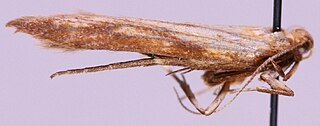
Metzneria neuropterella, the brown-veined neb, is a moth of the family Gelechiidae. It is found from most of Europe to the southern Ural Mountains, the Caucasus, southern and south-eastern Siberia and Mongolia, as well as in North Africa. The habitat consist of short-turfed, herb rich chalk downland.
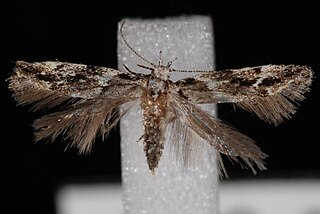
Recurvaria nanella, the lesser bud moth, is a moth of the family Gelechiidae. It is widely distributed in Europe and is also found in Turkey, the Near East, North Africa, the Caucasus, Transcaucasia, Kazakhstan and south-eastern Siberia. It is also found in North America, where it is probably introduced.
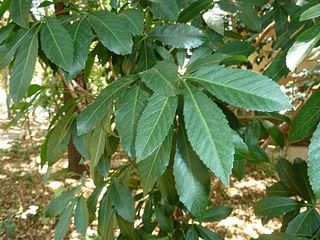
Allophylus natalensis, commonly known as the dune false crowberry or dune false currant, is a species of plant in the genus Allophylus native to south-eastern Africa.


















